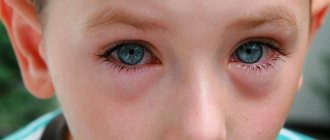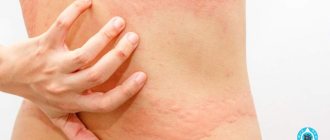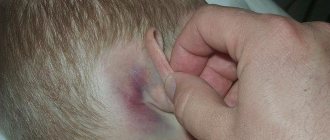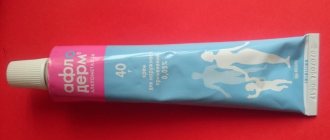The child's body, especially newborns and infants, is very sensitive to various irritants and is susceptible to such a phenomenon as allergies on the skin with red spots in the child. Provocative substances come from food (breast milk, complementary foods), act through clothing, and the environment. It is important to distinguish red spots of an allergic nature from similar signs resulting from infectious and other diseases.
Red spots - what kind of animal is this and how to recognize it
Based on external signs, dermatologists divide types of pathology into:
1) Primary:
- spots;
- Ulcers (pustule);
- Bubbles;
- blisters;
- Tubercles (nodules);
- Papule.
The spots usually do not protrude beyond the epidermis and their outlines do not have a specific shape. The size of the spots varies from 5 mm to 2 cm. If patients with scarlet fever have pinpoint rashes (roseola) no larger than half a centimeter in size, then a baby with measles has a lot of large red spots on the body, their size varies from 1 to 2 cm. Dense blisters formed with liquid during eczema, allergic reactions, herpes.

Blisters occur, for example, with hives, as a result of swelling of the inner layer of the skin. A papule that is dense or soft in consistency does not leave any traces after treatment, but if during treatment the papules grow together into one large plaque, then this brings a lot of discomfort to the sick child. When pressed with your fingers, the bumps change color, which depends on the root cause of the disease.
2) Secondary:
- Dark spots;
- Crusts (scales);
- Cracks;
- Erosion.
Causes and factors for the manifestation of red spots
Due to the fact that children's skin is capable of regeneration much better, most signs of rashes disappear without a trace after treatment. However, some elements may not completely disappear.
When examining a patient’s skin, doctors take into account not only the size, color and shape of the formations. They can press on the spots to see if they disappear with pressure or not, and how quickly they form again. If redness is accompanied by swelling of the dermis, then the spots do not disappear upon palpation. The doctor may also be interested in the presence of itching or a sudden cough, as well as fever, sore throat or general intoxication of the body.
Typical childhood illnesses
Chickenpox is an infectious disease with an incubation period of about three weeks, so initially children experience loss of appetite, runny nose, sore throat and stomach, weakness, and fever. After a few days, the body temperature rises sharply, and the skin begins to become covered with red spots, which then turn into itchy blisters. Chickenpox in infants, however, occurs mostly without fever.
Measles - during this infectious disease, the incubation period of which is about two weeks, respectively, there is a danger to others for five days. The baby has a high fever, runny nose, and a painful reaction to light. Red spots with scalloped edges tend to coalesce and then peel. The color of the spots varies from red to brown. When examining the throat, the doctor may notice pinpoint rashes on the inside of the cheeks.
Rubella - during this disease, small red spots appear on the baby's bottom, and also cover the face and most areas on the arms and legs. Body temperature rarely deviates from normal values, intoxication of the body and redness in the throat are almost not observed, but the lymph nodes in the neck are noticeably enlarged. A pleasant point is the fact that the stains do not linger for long, disappear literally after 3 days and do not leave any traces.
Scarlet fever is a streptococcal infection that begins with fever and sore throat. After 1-2 days, the mother may notice that the baby’s skin is covered with a small reddish rash, with the largest accumulation of pink dots observed in the folds (in the groin, on the neck, in the armpits). Within a week, the rash begins to fade and turns into flaky elements. At the same time, signs of lacunar tonsillitis appear: fever, ragged white plaque on the palate, coated tongue, pallor in the area of the nasolabial triangle.
Erythema - red formations on the skin are infectious in nature. The face of babies becomes covered with a small rash from the first day of the disease, then red, large-spotted lesions with an uneven relief (butterfly-shaped) spread further throughout the body. The disease lasts about 15 days and does not leave any visual consequences.
Infantile roseola is a sudden exanthema that occurs under the influence of the herpes virus and requires competent treatment. At the onset of the disease, body temperature rises and lasts about 4 days. On the fifth day, you can notice dry pink spots on the skin no more than 5 mm in diameter. Basically, the spots are localized in the cervical region and on the trunk and are almost never observed on the face or limbs. In addition to febrile values on the thermometer, the disease is also characterized by possible convulsions and mild intoxication. As a rule, symptomatic treatment is sufficient.

Red spots on a child’s body (photo with description)
Now let's look at more serious infectious and allergic diseases, which, in addition to skin rashes, are characterized by a number of the symptoms described above and, if left untreated for a long time, can lead to a very disastrous outcome.
Among the infectious and parasitic diseases that manifest themselves in the form of redness on the body are:
- measles,
- chicken pox,
- rubella,
- scarlet fever,
- erythema infectiosum,
- roseola, sudden exanthema,
- meningococcal infection,
- felinosis,
- herpetic infection,
- enteroviral vesicular stomatitis,
- Infectious mononucleosis,
- pseudotuberculosis and yersiniosis,
- scabies,
- molluscum contagiosum.
Allergy: forms of its manifestation
Due to the fact that children's immunity is quite vulnerable, any external manifestations, as well as nutrition, can cause allergies, which manifest themselves in the form of a rash or red spots of various etymologies. A characteristic feature of all forms of allergies is unbearable itching.
The rashes resemble nettle burns, which is why they are called “urticaria.” At best, blisters will cover the head, torso, arms and legs, and groin folds. At worst, the allergen can cause Quincke's edema, when it becomes impossible to breathe due to severe swelling of the larynx. Despite the fact that the disease lasts only 1-2 days, the rashes constantly disappear and new ones form, and the child’s red spots on the body itch quite intensely.
Proper care for babies
In infants, irritation of delicate baby skin occurs from wet diapers, overheating, and also from high humidity in the room. Miliaria affects the testicles and groin area in boys and the vulva in girls, and is also localized in the armpits and neck. It is necessary to carefully choose products for caring for children's skin and it is advisable to wash the baby immediately after bowel movements instead of using wet wipes.
Attention! Infants are especially sensitive to dry indoor air, chlorine-treated water or herbal bathing additives - as a result, rough spots form under the knees and on the outside of the thighs and legs in newborns.
Among the common causes of allergic red spots are insect bites. On the one hand, the injected substance is itself an allergen and causes redness, swelling, and itching. On the other hand, where have you seen children who would not scratch the place where the bite was?
As a result, a wound is formed and an infection is introduced from the outside, which can be much more dangerous than insect poison. Babies are especially vulnerable in this situation, since they do not control their emotions, so the mother needs to urgently take measures to eliminate the itching if she notices that her child is itching.
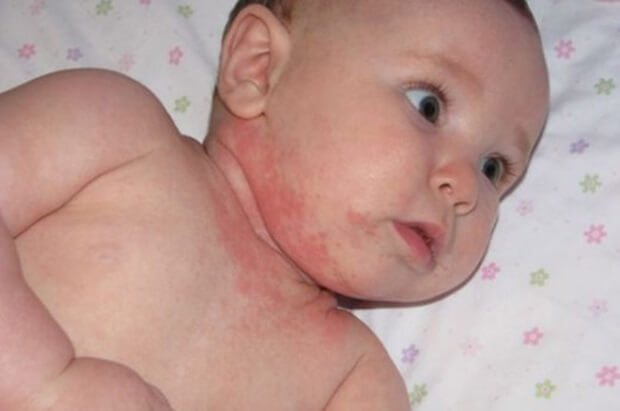
Red spots on the body of a child without fever
Of course, it also happens that redness is present, but there are no other ailments. Should I be concerned in this case and what could cause the change in skin color?
When we are not talking about an infectious disease, but about improper hygiene, the absence of temperature is quite a common occurrence. In this case, the baby is restless, since the intimate areas are most often affected and sitting and even lying down cause him pain. Mothers should pay attention to how often they wash their baby and what hygiene products they use.
Miliaria and diaper rash are quite common in infants, since the delicate skin becomes irritated by prolonged contact with urine and feces that accumulate in the diaper. The use of special creams (Bepanten, etc.), as well as proper hygiene, will help cope with the problem.
Allergic reaction to the sun
Photodermatitis is an allergy due to exposure to sunlight. Increased sensitivity to ultraviolet radiation is caused by special substances that either enter the body along with external factors (cosmetics, medications, etc.), or are produced by the body itself if liver pathology is present.
atopic dermatitis has become increasingly popular among childhood diseases , with periods of exacerbation occurring in the winter and relative calm in the summer. This chronic disease has a characteristic distinguishing feature - red spots on the body turn white upon palpation due to impaired blood circulation in small vessels. The spots themselves are usually concentrated on a certain area of the body and change their shape and appearance with age.
For what reasons does spot allergy occur?
Parents of young children often have to deal with skin allergies - red spots on the child indicate the body's reaction to some irritant. The reasons for such phenomena are hidden in the diet, personal hygiene items and daily life. There are the following types of this disease with similar symptoms:
- Food. Occurs with excessive consumption of sweet, flour dishes, confectionery, and baked goods. Often caused by chocolate products, sugar, eggs, honey, citrus fruits, melons, berries and exotic fruits.
- Hives. Belongs to the group of allergic dermatitis caused by washing powders, unsuitable soaps, and shampoos. A local reaction can be triggered by poor-quality care products (creams, powders, lotions), plant pollen, and animal hair.
- Prickly heat. It often occurs in newborns and infants as a result of the wrong choice of clothing, elevated temperature in the apartment, infrequent bathing and careless care of the baby’s skin.
- Dermatitis, including atopic dermatitis. Most often it manifests itself as a child’s sensitivity to drugs (for example, penicillin drugs), sunlight (photodermatosis), and cold.
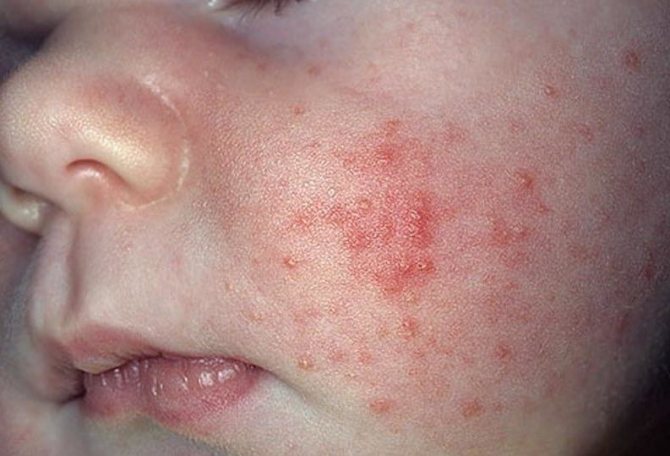
Eczema and lichen: main symptoms of diseases
Allergic eczema can also cause red, weeping spots in a child, which at the last stage (after 3-4 weeks) begin to peel off and form a crust. Unlike other allergic diseases, eczema spots can be triggered by an intestinal or viral infection, stress, overheating, and they disappear for a short time even with adequate treatment with physiotherapeutic procedures and anti-anxiety medications.
Another disease with a spotted rash in babies is lichen. The development of the disease begins with the formation of a rough, protruding spot in the case of pityriasis rosea and a small-spotted rash in the back of the head in case of ringworm. Gradually, spots begin to appear on other areas of the skin (including on the limbs). The spots continue to itch and sting, and subsequent plaques of pink to light red color up to 5 cm in size subsequently form.
On a note! Diathesis is an allergic reaction in newborns, localized on the baby’s cheeks and accompanied by constant itching and tingling. At the same time, the baby experiences vomiting or diarrhea. Therefore, in the first months of breastfeeding, the mother needs to carefully monitor her diet.
Diagnostics
To identify the cause of the rash, you need to seek help from a therapist and dermatologist. The therapist will confirm or rule out the presence of common diseases, and the dermatologist will examine the skin.
Diagnostics includes the following steps:
- CBC and blood biochemistry,
- blood test for allergy tests,
- examination of the body and lymph nodes,
- carrying out histological examination of samples of affected tissues,
- scraping and dermatoscopy (if suspicious elements are detected on the skin),
- Ultrasound examination of the abdominal cavity.
If a child has complaints of itching in the anus, it is advisable to consult a proctologist. He will perform a visual and digital examination and examination of the large intestine. You definitely need to have your stool tested.
In addition, to determine the cause of the disease, differential diagnosis is carried out, which involves excluding diseases that do not match any criteria and reduces the diagnosis to a single probable disease.
Since rashes and itching in a child can appear due to the development of various diseases, knowledge of all areas of clinical medicine is necessary.
First aid for red spots
Even if the rash or spots on the body do not itch and the child does not complain of discomfort, it is necessary to try to identify the possible cause of their occurrence and prevent further spread.
- In case of urticaria, the allergen that causes the allergic reaction should be eliminated:
- Highly allergenic foods (red fruits and berries, honey, confectionery, milk and egg whites, citrus fruits, etc.)
- Children's cosmetics (buy only cosmetics without fragrances and dyes)
- Synthetic clothing (if rubbed against the skin causes redness and itching)
- Prevent helminthiasis
- Discontinue the drug if signs of an allergic reaction occur.
- To prevent insects from itching, you should treat the reddened areas with antihistamines for children in the form of cream or drops (Fenistil, Zyrtec), which reduce the production of histamine in the body.
- To prevent and eliminate baby heat rashes or diaper dermatitis, use zinc ointment or specialized children's preparations Bepanten or Panthenol D. However, the products should be applied only to clean and dry skin.

Prevention
To prevent food allergies in young children, complementary foods should be introduced gradually and monitor the body's reaction. Any new dish in large quantities can provoke sensitization. This also applies to medications, so you should not self-medicate your child.
Measures to prevent allergies in the form of spots:
- monitor reactions to new products, medications, body care products;
- try to ensure that the baby has regular bowel movements (this will help remove toxins and allergens from the body faster);
- do not use medications with added dyes and flavors;
- use high-quality diapers, breathable bedding and underwear;
- do not keep animals in the house if the child is prone to allergies;
- ventilate the room and carry out wet cleaning.
Traditional recipes to prevent itching
People's Council! To stop the spots from itching due to chickenpox or other childhood ailments, dip the child in a bath with a weak solution of soda or potassium permanganate - it will reduce the itching and dry the wounds.
- To reduce inflammation in infantile eczema, the patient is given antihistamines and sedatives to prevent itching, which causes restlessness and irritability in the baby, and loss of appetite.
- To eliminate reddish rashes due to serious manifestations of allergies, infectious or autoimmune pathologies, hormonal corticosteroid drugs, silver-based medications, emollients, and other new generation drugs are used in combination.
Parents should first of all take care of the baby’s health, so you should not experiment with medications. Even if the rashes on your child’s body are unbearably itchy, do not try on them an ointment or cream that suits you or another child in the family. Unexpected side effects can cause more harm than good. The best effect will be achieved by means selected by an experienced specialist.



